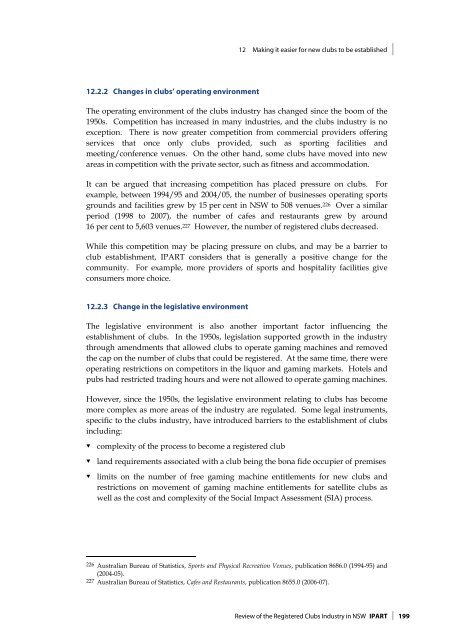Review of the Registered Clubs Industry in NSW - Clubs NSW
Review of the Registered Clubs Industry in NSW - Clubs NSW
Review of the Registered Clubs Industry in NSW - Clubs NSW
You also want an ePaper? Increase the reach of your titles
YUMPU automatically turns print PDFs into web optimized ePapers that Google loves.
12 Mak<strong>in</strong>g it easier for new clubs to be established<br />
12.2.2 Changes <strong>in</strong> clubs’ operat<strong>in</strong>g environment<br />
The operat<strong>in</strong>g environment <strong>of</strong> <strong>the</strong> clubs <strong>in</strong>dustry has changed s<strong>in</strong>ce <strong>the</strong> boom <strong>of</strong> <strong>the</strong><br />
1950s. Competition has <strong>in</strong>creased <strong>in</strong> many <strong>in</strong>dustries, and <strong>the</strong> clubs <strong>in</strong>dustry is no<br />
exception. There is now greater competition from commercial providers <strong>of</strong>fer<strong>in</strong>g<br />
services that once only clubs provided, such as sport<strong>in</strong>g facilities and<br />
meet<strong>in</strong>g/conference venues. On <strong>the</strong> o<strong>the</strong>r hand, some clubs have moved <strong>in</strong>to new<br />
areas <strong>in</strong> competition with <strong>the</strong> private sector, such as fitness and accommodation.<br />
It can be argued that <strong>in</strong>creas<strong>in</strong>g competition has placed pressure on clubs. For<br />
example, between 1994/95 and 2004/05, <strong>the</strong> number <strong>of</strong> bus<strong>in</strong>esses operat<strong>in</strong>g sports<br />
grounds and facilities grew by 15 per cent <strong>in</strong> <strong>NSW</strong> to 508 venues. 226 Over a similar<br />
period (1998 to 2007), <strong>the</strong> number <strong>of</strong> cafes and restaurants grew by around<br />
16 per cent to 5,603 venues. 227 However, <strong>the</strong> number <strong>of</strong> registered clubs decreased.<br />
While this competition may be plac<strong>in</strong>g pressure on clubs, and may be a barrier to<br />
club establishment, IPART considers that is generally a positive change for <strong>the</strong><br />
community. For example, more providers <strong>of</strong> sports and hospitality facilities give<br />
consumers more choice.<br />
12.2.3 Change <strong>in</strong> <strong>the</strong> legislative environment<br />
The legislative environment is also ano<strong>the</strong>r important factor <strong>in</strong>fluenc<strong>in</strong>g <strong>the</strong><br />
establishment <strong>of</strong> clubs. In <strong>the</strong> 1950s, legislation supported growth <strong>in</strong> <strong>the</strong> <strong>in</strong>dustry<br />
through amendments that allowed clubs to operate gam<strong>in</strong>g mach<strong>in</strong>es and removed<br />
<strong>the</strong> cap on <strong>the</strong> number <strong>of</strong> clubs that could be registered. At <strong>the</strong> same time, <strong>the</strong>re were<br />
operat<strong>in</strong>g restrictions on competitors <strong>in</strong> <strong>the</strong> liquor and gam<strong>in</strong>g markets. Hotels and<br />
pubs had restricted trad<strong>in</strong>g hours and were not allowed to operate gam<strong>in</strong>g mach<strong>in</strong>es.<br />
However, s<strong>in</strong>ce <strong>the</strong> 1950s, <strong>the</strong> legislative environment relat<strong>in</strong>g to clubs has become<br />
more complex as more areas <strong>of</strong> <strong>the</strong> <strong>in</strong>dustry are regulated. Some legal <strong>in</strong>struments,<br />
specific to <strong>the</strong> clubs <strong>in</strong>dustry, have <strong>in</strong>troduced barriers to <strong>the</strong> establishment <strong>of</strong> clubs<br />
<strong>in</strong>clud<strong>in</strong>g:<br />
<br />
<br />
<br />
complexity <strong>of</strong> <strong>the</strong> process to become a registered club<br />
land requirements associated with a club be<strong>in</strong>g <strong>the</strong> bona fide occupier <strong>of</strong> premises<br />
limits on <strong>the</strong> number <strong>of</strong> free gam<strong>in</strong>g mach<strong>in</strong>e entitlements for new clubs and<br />
restrictions on movement <strong>of</strong> gam<strong>in</strong>g mach<strong>in</strong>e entitlements for satellite clubs as<br />
well as <strong>the</strong> cost and complexity <strong>of</strong> <strong>the</strong> Social Impact Assessment (SIA) process.<br />
226 Australian Bureau <strong>of</strong> Statistics, Sports and Physical Recreation Venues, publication 8686.0 (1994-95) and<br />
(2004-05).<br />
227 Australian Bureau <strong>of</strong> Statistics, Cafes and Restaurants, publication 8655.0 (2006-07).<br />
<strong>Review</strong> <strong>of</strong> <strong>the</strong> <strong>Registered</strong> <strong>Clubs</strong> <strong>Industry</strong> <strong>in</strong> <strong>NSW</strong> IPART 199
















